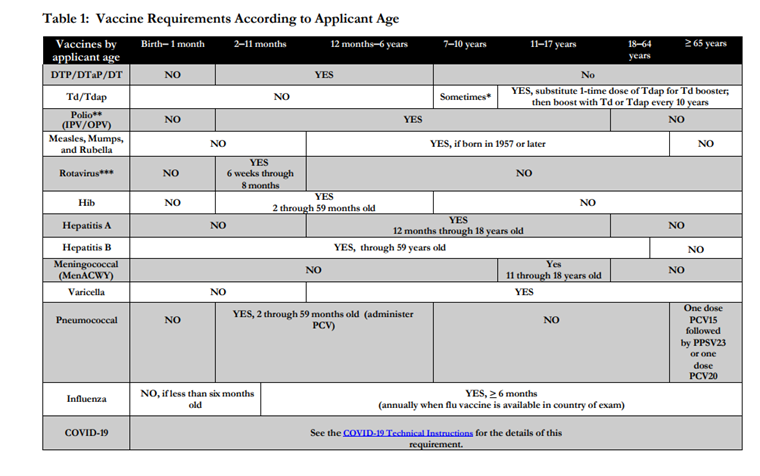Os Meus Exames Médicos Estão Corretos?
Click here to read this article in English
Como parte do processo de aplicação do Formulário I-485, Ajuste de Status, ou do processo de Visto de Imigrante, se o requerente estiver aplicando do exterior, a USCIS exige que todos os requerentes estejam devidamente vacinados e tenham o Formulário I-693 devidamente preenchido, que é o formulário de Exame Médico preparado por um Cirurgião Civil ou Médicos cadastrados e autorizados pela USCIS, e enviado a USCIS em um envelope lacrado.
Infelizmente, muitos requerentes e profissionais de imigração frequentemente se deparam com situações em que o cirurgião ou médico autorizado não completou adequadamente o exame médico, o que resultou em consequências prejudiciais para o processo de ajuste deles, incluindo a negação do Formulário I-485 ou do pedido de Visto de Imigrante.
Primeiramente, o Cirurgião Civil ou Médico cadastrado deve fornecer ao requerente uma cópia dos resultados do exame médico que está sendo lacrado e enviado a USCIS. Dessa forma, o requerente e/ou seu advogado de imigração podem visualizar e verificar os resultados antes de enviar o envelope lacrado a USCIS. Isso evitará que exames médicos erroneamente preenchidos sejam enviados a USCIS e reduzirá as chances de que o Formulário I-485 seja negado ou afetado negativamente por um exame médico deficiente.
Em segundo lugar, o requerente ou seu advogado de imigração (se tiver um) deve revisar a cópia do exame médico que lhes é fornecida e garantir que esteja preenchida de acordo com os requisitos de vacinação da USCIS e CDC. Esses requisitos podem ser encontrados nos seguintes sites:
https://www.uscis.gov/tools/designated-civil-surgeons/vaccination-requirements
https://www.cdc.gov/immigrantrefugeehealth/civil-surgeons/vaccinations.html
A Lei de Imigração e Nacionalidade (INA)¹ especifica que as seguintes vacinas devem ser administradas ou concluídas como parte do exame médico:
- Caxumba, sarampo, rubéola;
- Poliomielite;
- Tétano e toxoides diftéricos;²
- Coqueluche;
- Haemophilus influenza tipo B; e
- Hepatite B.
- Os CDC exigem as seguintes vacinas adicionais para fins de imigração:
- Varicela;
- Gripe;
- Pneumonia pneumocócica;
- Rotavírus;
- Hepatite A;
- Meningococo; e
- COVID-19.
Se o requerente não tiver recebido nenhuma das vacinas listadas e as vacinas forem apropriadas para sua idade e clinicamente adequadas, o requerente tem uma condição de Classe A e é inadmissível. Geralmente, todas as linhas de vacinas apropriadas para a idade na avaliação de vacinação devem ter pelo menos uma dose antes que a avaliação possa ser considerada como devidamente concluída. No entanto, a vacinação contra a COVID-19 (obrigatória a partir de 1º de outubro de 2021) difere, pois o requerente deve concluir toda a série de vacinas (uma ou duas doses, dependendo da formulação).³
Para determinar quais vacinas são "apropriadas para a idade", o Cirurgião Civil ou Médico cadastrado deve consultar o gráfico de requisitos de vacinação contido nas Instruções Técnicas de Vacinação dos CDC. Veja este gráfico abaixo⁴:

Se você tiver dúvidas sobre os exames médicos exigidos pela USCIS ou se o seu Formulário I-693 foi preenchido corretamente, por favor, entre em contato com nosso escritório para obter assistência hoje mesmo!
¹ Veja INA 212(a)(1)(A)(ii).
²
Os requerentes que tiverem concluído a série inicial de DTP/DTaP/DT ou Td/Tdap devem receber uma dose de reforço de Td/Tdap a cada 10 anos. Se a última dose tiver sido recebida há mais de 10 anos, o candidato deverá tomar a vacina de reforço; caso contrário, ele será inadmissível de acordo com a INA 212(a)(1)(A)(ii).
³ Para obter mais informações, incluindo os requisitos atuais de dosagem para o exame médico de imigração, consulte a página da Web :CDC Requirements for Immigrant Medical Examinations: COVID-19 Technical Instructions for Civil Surgeons
⁴ https://www.cdc.gov/immigrantrefugeehealth/civil-surgeons/vaccinations.html
Este blog não se destina a fornecer aconselhamento jurídico e nada aqui deve ser interpretado como estabelecimento de um relacionamento advogado-cliente. Por favor, agende uma consulta com um advogado de imigração antes de agir com base em qualquer informação lida aqui.






